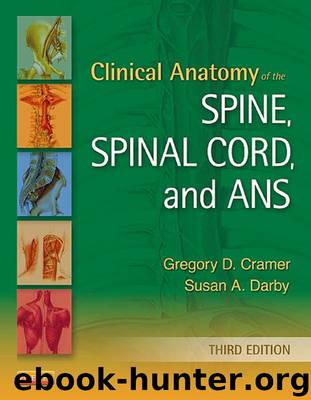Clinical Anatomy of the Spine, Spinal Cord, and ANS by Gregory D. Cramer

Author:Gregory D. Cramer [Cramer, Gregory D.; Darby, Susan A.]
Language: eng
Format: epub
ISBN: 978-0-323-08231-0
Publisher: Elsevier Health Sciences
Published: 2014-06-14T16:00:00+00:00
Peripheral Nervous System
Peripheral Receptors
Peripheral receptors are sensory endings of peripheral nerves; they are scattered throughout the body. They are found in great numbers along the vertebral column and within the ligaments, muscles, and skin that surround the spine. These receptors and the sensory systems that transmit their input provide information concerning one’s environment. Each receptor is sensitive to a particular form of physical energy, or stimulus, and transduces the stimulus into electrochemical energy or an action potential, which is the “language” the central nervous system (CNS) can understand.
Receptors may be divided into two types, rapidly adapting and slowly adapting. A slowly adapting receptor, such as a Merkel’s disc, responds continuously to a sustained stimulus, whereas a rapidly adapting receptor does not. A rapidly adapting receptor, such as a pacinian corpuscle, responds to any dynamic change in the receptor. For example, if the pressure onto a pacinian corpuscle is continuously increased, the corpuscle will continue to produce action potentials until the stimulus strength becomes constant. A stimulus furnishes a receptor with four basic characteristics: modality (type of stimulus), intensity (strength of stimulus), duration (perceived time that the stimulus is present), and location (where on the body the stimulus is being perceived). When a receptor is adequately stimulated, a generator potential occurs across its membrane and may lead to an action potential. The action potential propagates along the sensory neuron into the CNS. The CNS then is able to combine the four characteristics of the stimulus into a perceived sensation.
The sensory neurons of the peripheral nervous system (PNS) are pseudounipolar neurons. Their cell bodies are located in the dorsal root ganglia. The peripheral process, which may be myelinated or unmyelinated, is the part of the fiber continuous with the receptor. It is the sensory component of a peripheral nerve. The other part of the fiber, the central process, enters the CNS. A bundle of central processes forms a dorsal root. The peripheral processes are classified according to their conduction velocity, and conduction velocity is related to the axon diameter. Fibers with large diameters conduct the fastest. Based on the relationship between velocity and diameter, cutaneous fibers are classified alphabetically as Aβ (beta), Aδ (delta), and C fibers. Similarly, afferents from muscle tissue usually are classified numerically from heavily myelinated to unmyelinated as I, II, III, and IV. Type I also has subgroups of Ia and Ib. Afferents from visceral interoceptors often are classified as Aδand C fibers. Motor (efferent) fibers also are classified according to the alphabetic listing. Large somatic motor neurons correspond to the Aα(alpha) and Aγ(gamma) group, and autonomic efferent fibers correspond to the B and C groups. Table 9-1 summarizes the classifications of the afferent and efferent fibers.
Table 9-1
Summary of the Classification of Peripheral Fibers
Download
This site does not store any files on its server. We only index and link to content provided by other sites. Please contact the content providers to delete copyright contents if any and email us, we'll remove relevant links or contents immediately.
Dynamic Alignment Through Imagery by Eric Franklin(4118)
Body Love by Kelly LeVeque(3014)
Barron's AP Calculus by David Bock(1778)
EMT Exam For Dummies with Online Practice by Arthur Hsieh(1651)
The Juice Lady's Remedies for Asthma and Allergies by Cherie Calbom(1604)
Fitness Walking For Dummies by Liz Neporent(1531)
Flight by Elephant(1484)
Extremes: Life, Death and the Limits of the Human Body by Fong Kevin(1484)
McGraw-Hill Nurses Drug Handbook by Patricia Schull(1466)
The Natural First Aid Handbook by Brigitte Mars(1433)
Tell by Major Margaret Witt(1380)
Skin by Unknown(1369)
Seeing Voices by Oliver Sacks(1359)
Born to Walk by James Earls(1278)
The Yoga Bible by Christina Brown(1264)
Cracking the Nursing Interview by Jim Keogh(1253)
First Aid for Colleges and Universities (10th Edition) by Mistovich Joseph J. & Limmer Daniel J. & Karren Keith J. & Hafen Brent Q(1233)
The Advantage by Lencioni Patrick M(1170)
Living Ready Pocket Manual - First Aid: Fundamentals for Survival by James Hubbard(1160)
